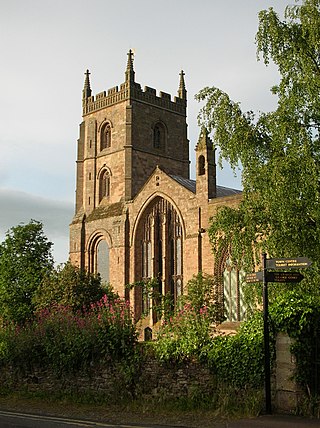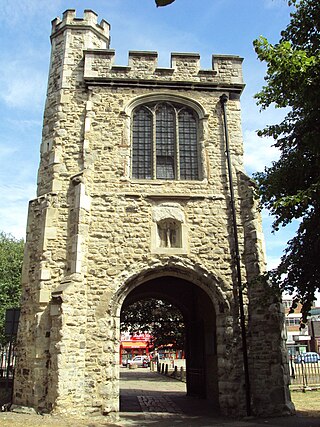Related Research Articles

Eadburh was the daughter of King Edward the Elder of England and his third wife, Eadgifu of Kent. She lived most of her life as a nun known for her singing ability. Most of the information about her comes from hagiographies written several centuries after her life. She was canonised twelve years after her death and there are a small number of churches dedicated to her, most of which are located near Worcestershire, where she lived.

Shaftesbury Abbey was an abbey that housed nuns in Shaftesbury, Dorset. It was founded in about 888, and dissolved in 1539 during the English Reformation by the order of Thomas Cromwell, minister to King Henry VIII. At the time it was the second-wealthiest nunnery in England, behind only Syon Abbey.
Ealhswith or Ealswitha was wife to King Alfred the Great. She was one of the most powerful noble women in early medieval England during the time of the Vikings. She was mother to King Edward the Elder who succeeded King Alfred to the Anglo-Saxon throne. Her father was a Mercian nobleman, Æthelred Mucel, Ealdorman of the Gaini, which is thought to be an old Mercian tribal group. Her mother was Eadburh, a member of the Mercian royal family and her lineage was one of the primary reasons for Alfred taking Ealhswith as his wife. Her legacy persists; after her death in the nunnery she founded and in the estates left to her by Alfred.

Wilton Abbey was a Benedictine convent in Wiltshire, England, three miles west of Salisbury, probably on the site now occupied by Wilton House. It was active from the early tenth century until 1539.

Leoba, was an Anglo-Saxon Benedictine nun and is recognized as a saint. In 746 she and others left Wimborne Minster in Dorset to join her kinsman Boniface in his mission to the German people. She was a learned woman and was involved in the foundation of nunneries in Kitzingen and Ochsenfurt. She had a leading role in evangelizing the area. Leoba was acclaimed for many miracles: saving a village from fire; saving a town from a terrible storm; protecting the reputation of the nuns in her convent; and saving the life of a fellow nun who was gravely ill – all accomplished through prayer. Her first letter to Boniface contains the first poetry known to have been written by an English woman. |

Edith of Wilton was an English saint, nun and member of the community at Wilton Abbey, and the daughter of Edgar, King of England and Saint Wulfthryth. Edith's parents might have been married and Edgar might have abducted Wulfthryth from Wilton Abbey, but when Edith was an infant, Wulfthryth returned with Edith and their marriage was dissolved. Edith and her mother remained at Wilton for the rest of their lives.

Godstow is a hamlet about 2.5 miles (4 km) northwest of the centre of Oxford. It lies on the banks of the River Thames between the villages of Wolvercote to the east and Wytham to the west. The ruins of Godstow Abbey, also known as Godstow Nunnery, are here. A bridge spans the Thames and the Trout Inn is at the foot of the bridge across the river from the abbey ruins. There is also a weir and Godstow lock.

A cartulary or chartulary, also called pancarta or codex diplomaticus, is a medieval manuscript volume or roll (rotulus) containing transcriptions of original documents relating to the foundation, privileges, and legal rights of ecclesiastical establishments, municipal corporations, industrial associations, institutions of learning, or families. The term is sometimes also applied to collections of original documents bound in one volume or attached to one another so as to form a roll, as well as to custodians of such collections.

Barking Abbey is a former royal monastery located in Barking, in the London Borough of Barking and Dagenham. It has been described as having been "one of the most important nunneries in the country".
Amesbury Priory was a Benedictine monastery at Amesbury in Wiltshire, England, belonging to the Order of Fontevraud. It was founded in 1177 to replace the earlier Amesbury Abbey, a Saxon foundation established about the year 979. The Anglo-Norman Amesbury Priory was disbanded at the Dissolution of the monasteries and ceased to exist as a monastic house in 1539.
Wherwell Abbey was an abbey of Benedictine nuns in Wherwell, Hampshire, England.

Leominster abbey was an Anglo-Saxon monastery established at Leominster in the county of Hereford, England. The name of the town refers to its minster, a settlement of clergy living a communal life.

Markyate Priory was a Benedictine priory in Bedfordshire, England. It was established in 1145 and disestablished in 1537.

Hildelith of Barking, also known as Hildilid or Hildelitha, was an 8th-century Christian saint, from Anglo-Saxon England but was of foreign origin.
Wulfthryth, also known as Wilfrida, was the second known consort of Edgar, King of England, in the early 960s. Historians disagree whether she was his wife or mistress. In 964, Edgar married Ælfthryth, and then or earlier Wulfthryth returned to Wilton Abbey, where she had been educated. She was accompanied by her daughter Edith, who was widely revered in the eleventh century as a saint. Wulfthryth remained there for the rest of her life as abbess and died on 21 September in an unknown year, around 1000. She was regarded as a saint at Wilton, but her cult did not spread more widely.
Wulfhilda, also known as Wulfhild and Wulfreda among several other names, was an Anglo-Saxon abbess who is venerated as a saint in the Catholic Church.

Sybil Montagu or Montague or de Montague or Montacute was a daughter of John de Montagu, 1st Baron Montagu and his wife Margaret de Monthermer. At an unknown date she entered Amesbury Priory and became a nun, then in 1391 was elected the monastery's prioress. Her vigorous government led to a few stormy years in the monastery, in the period when the conflict between Richard II and his eventual successor Henry IV came to a head. She weathered that and later storms and died as prioress in 1420.
Mary Percy (1570–1642) was an English noblewoman who founded an English Benedictine Monastery in Brussels and served as its abbess.
Elizabeth Felmersham became the English abbess of the Benedictine Godstow Abbey at a time when the abbey was not well regulated.
Matilda de Bailleul aka Maud was a Flemish abbess of the English Wherwell Abbey. She arrived in 1173 and transformed the abbey that had few nuns following damage done by William of Ypres years before. She annotated and then gifted an illuminated psalter to her successors which is known as the Saint Bertin psalter.
References
- 1 2 3 4 Orme, Nicholas (3 January 2008) [23 September 2004]. "Henley, Alice (d. 1470), abbess of Godstow" . Oxford Dictionary of National Biography (online ed.). Oxford University Press. doi:10.1093/ref:odnb/54450 . Retrieved 8 January 2025.(Subscription or UK public library membership required.)
- ↑ Orme, Nicholas (1 January 2006). Medieval Schools: From Roman Britain to Renaissance England. Yale University Press. p. 276. ISBN 978-0-300-11102-6.
- ↑ Power, Eileen (31 October 2010). Medieval English Nunneries: C.1275 to 1535. Cambridge University Press. pp. 252–253. ISBN 978-1-108-01714-5.
- 1 2 Eckenstein, Lina (1896). Woman Under Monasticism: Chapters on Saint-lore and Convent Life Between A.D. 500 and A.D. 1500. University Press. pp. 359–360. ISBN 978-0-7905-4226-3.
- ↑ Oliva, Marilyn (1998). The Convent and the Community in Late Medieval England: Female Monasteries in the Diocese of Norwich, 1350-1540. Boydell & Brewer Ltd. p. 75. ISBN 978-0-85115-576-0.
- ↑ Bugyis, Katie Ann-Marie (1 April 2019). The Care of Nuns: The Ministries of Benedictine Women in England during the Central Middle Ages. Oxford University Press. p. 242. ISBN 978-0-19-085130-9.